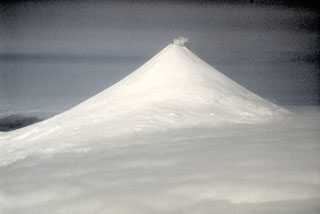Report on Shishaldin (United States) — 3 December-9 December 2014
Smithsonian Institution / US Geological Survey
Weekly Volcanic Activity Report, 3 December-9 December 2014
Managing Editor: Sally Sennert.
Please cite this report as:
Global Volcanism Program, 2014. Report on Shishaldin (United States) (Sennert, S, ed.). Weekly Volcanic Activity Report, 3 December-9 December 2014. Smithsonian Institution and US Geological Survey.
Shishaldin
United States
54.756°N, 163.97°W; summit elev. 2857 m
All times are local (unless otherwise noted)
AVO reported that seismicity at Shishaldin continued to be elevated during 3-9 December. Thermal anomalies were often detected in satellite images during periods of clear weather. Webcam images on 9 December showed minor steam emissions. A low-level lava eruption was likely still occurring within the summit crater of the volcano. The Aviation Color Code remained at Orange and the Volcano Alert Level remained at Watch.
Geological Summary. The symmetrical glacier-covered Shishaldin in the Aleutian Islands is the westernmost of three large stratovolcanoes in the eastern half of Unimak Island. The Aleuts named the volcano Sisquk, meaning "mountain which points the way when I am lost." Constructed atop an older glacially dissected edifice, it is largely basaltic in composition. Remnants of an older edifice are exposed on the W and NE sides at 1,500-1,800 m elevation. There are over two dozen pyroclastic cones on its NW flank, which is covered by massive aa lava flows. Frequent explosive activity, primarily consisting of Strombolian ash eruptions from the small summit crater, but sometimes producing lava flows, has been recorded since the 18th century. A steam plume often rises from the summit crater.
Source: US Geological Survey Alaska Volcano Observatory (AVO)

